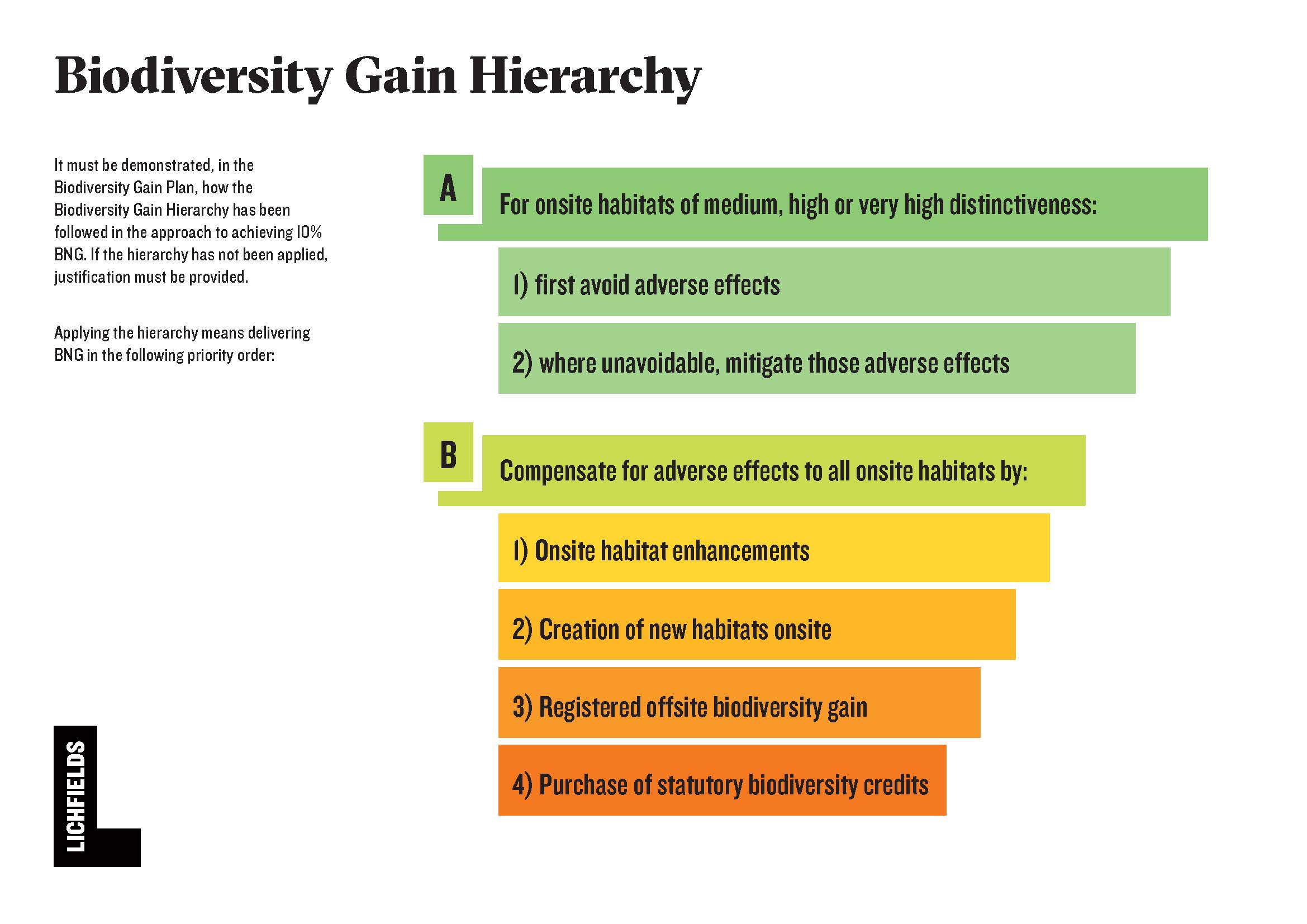Today marks a key change in the planning system with the mandatory requirement for developments to achieve a 10% Biodiversity Net Gain (BNG) coming into force for major planning applications.
Lichfields has summarised the new process in a
BNG Timeline showing how development will need to respond from the initial pre-application stage to managing and monitoring any habitats in the long term or for at least 30 years.
How this affects the Planning System and Application Process
In England, BNG is mandatory under Schedule 7A of the Town and Country Planning Act 1990 (as inserted by Schedule 14 of the Environment Act 2021). While online government draft guidance provides a step-by-step guide for developers, our timeline will assist built environment professionals to navigate their responsibilities under these changes to the planning system.
The Pre-Application Stage
Is the development exempt?
Many developments will not be exempt from new mandatory BNG requirements on the 12 February. Therefore, at the pre-application stage the developers and planning professionals alike will have to become accustomed to incorporating mandatory BNG requirements into development proposals early.
As a first step in the planning process, it should be identified whether the statutory BNG requirements apply to a proposed development. The number of applications subject to mandatory BNG will increase significantly on the 2 April 2024 when the exemption for ‘small developments’ disappears
[1].
Consider appointing an ecologist early.
The appointment of an ecologist to undertake an assessment of a site’s baseline habitats and to take initial metric calculations will be required for many, including those wishing to establish whether they may be exempt.
Ecologists can also help with providing valuable information to support pre-application discussions. For example, a draft Biodiversity Gain Plan, which will often need to be prepared by an ecologist, is likely to be reviewed early on.
To help applicants understand whether their proposed developments will have to achieve 10% BNG, or if it is exempt, Lichfields has prepared a useful
Flowchart.
Preparation and Submission of the Application
The national statutory submission requirements have been updated and with these have come a lot of new terminology. We’ve summarised key terms in our BNG Glossary alongside the Timeline in our BNG Glossary.
When preparing the planning submission for any application the statutory submission requirements will now include:
-
A statement confirming that the planning permission would not be subject to a BNG pre-commencement condition; or
-
Relevant information including the pre-development biodiversity value of the site’s habitats using the Statutory Metric, a map of these habitats, and confirmation of whether they have been degraded or are irreplaceable.
Local validation requirements could go beyond these requirements once BNG becomes mandatory as validation checklists are updated and new local plans adopted.
Planning Decision
Compliance with the Biodiversity Gain Condition
If BNG is required, the decisionmaker will apply a pre-commencement condition to the Decision Notice that requires the submission and approval of a Biodiversity Gain Plan prior to commencing the development. The Biodiversity Gain Plan will need to demonstrate how the Biodiversity Gain Hierarchy has been followed in the approach to achieving 10% BNG.
This condition cannot be varied or removed by a Section 73 application, even for viability reasons, and a Biodiversity Gain Plan cannot be submitted until after planning permission has been issued. A template for the Biodiversity Gain Plan is provided as part of the government's online BNG guidance.
If there will be significant on-site enhancements to biodiversity or off-site gains, a legal agreement may be required to secure the land being enhanced, which may involve a Habitat Management and Monitoring Plan or equivalent. All off-site gains will need to be registered on the Biodiversity Gain Site Register.
Thirty years later…
BNG is one of the tools intended to help the UK meet its biodiversity targets including halting the decline in the abundance of species by 2030. We will have to wait and see whether the implementation of mandatory BNG will have this much needed positive outcome and in the meantime we are hoping its roll out will be smooth. Beyond the 2030 target date, biodiversity gain sites will continue to be managed and monitored in line with the requirement to do so for at least 30 years. While we cannot tell what will happen by then or if BNG will still be a requirement at that time, we can all use our relevant expertise and share our experiences to help pave the way and avoid heavy delays.
There is plenty of scope for the BNG requirements to develop over the coming years and for the associated validation requirements and government guidance to evolve alongside the development of decision makers’ experience with BNG. If this significantly changes the BNG planning process, we will update the resources linked below - stay tuned!
How can we help?
Get in touch if you need any help or advice navigating your way through BNG - we can help with general advice, finding offsite gains, discharging a BNG condition or anything in-between.
[1] Defined in the exemptions regulations as any development which is not major development within the DMPO.




